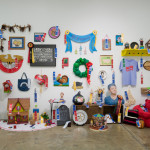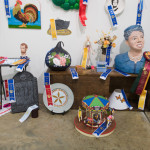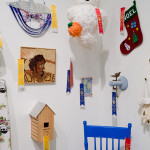By MICAH J. MALONE
Anissa Mack's recent exhibition at Small a Projects does something extraordinary: she participates in a "local" community's practice without irony. Considering her subject matter is local crafters at a country fair, this is no small accomplishment. For her exhibition "The Last Full Weekend Each September" Mack executed every possible craft category for the Durham Fair, the largest agricultural fair in Connecticut, which has occurred every last full weekend of September since 1916. At Small a, we see her efforts displayed, prize ribbons included, in two sets of object collages, one executed in 1997 and her current anniversary project from last year. "Ceramics-decorative item", "Christmas-other article" and "Dolls, toy or game- not wood" are just a few of the 69 categories, making the work needed for this fair astonishingly specific, but more importantly, local.
The notion of "local" and how artists actively engage and create an audience or sub-culture outside of the gallery system has been a major topic for almost two decades. Nicolas Bourriaud's book "Relational Aesthetics" characterized much of this practice in the 90s and speculated on the implications for including an audience in the production of art. Today, Bourriaud's book is required reading for any artist engaged in "Social Practice" (a popular term in Portland, OR and the title of Harrell Fletcher's grad program at PSU) or "Relational Aesthetics", or whichever tagline one is using.
In the current Whitney Biennial, much has been made of "local" strategies employed by many of the artists. Curators Shamim Momin and Henriette Huldisch describe much of the work as "a tendency toward smaller, more localized gestures..." This localization takes its form in a wide range of projects such as serving dinner to an open audience, operating a tequila bar, distributing pamphlets, sending out questionnaires, and so on (Boston's Kanarinka certainly belong in this dialog as well). The Biennial's locality seems to exist for yet more incarnations of 90s relational aesthetics and bringing together post-grad school students for reunions. However, Mack's humble craft contest participation strikes me as a more precise locality than exploring the networks that exist among contemporary artists.
Of course, the point is not to create a litmus test for how local something is, how authentic one can translate an underground sub-culture into the demands of contemporary art. The point, it seems, is to include the audience, to make them intrinsic to the artwork. Yet for all this inclusion witnessing the majority of today's relational aesthetics leaves a feeling of alienation rather than inclusion. In part, because these "localized" gestures operate in a vacuum, they exist for the networked individuals who have organized the event, originally attended by and made for their friends. Which is fantastic in its own way because hanging out with friends and drinking tequila is fun. However, things change drastically when these events are translated to venues outside the original location (often apartments or vacant warehouses). The Whitney Biennial and most commercial galleries change these events to make participation a command rather than an organic happening.
Which is precisely the opposite affect with Mack's project. The crafted objects oscillate between nostalgia (my aunt made something similar to that when I was little!), awe (that is a rather beautiful carousal), simple humor (check out the gravestone with the cartoony R.I.P.), or just plain ridiculous (I'm thinking of that sequined Christmas wreath). While Mack's participation and investment in this fair is clear, her exhibition does not induce participation, but rather presents a part of Americana that is fading, one based entirely on bringing a local community together once a year. Art viewers are not meant to participate, but it does motivate me to find my own local fair and draw comparisons, maybe even make a wreath. Point being, my participation would be just that: MY participation. Not just a part of someone's art project, but actions resulting from the inspiration of art.
Mack's distinction is her direct engagement that does not require participation beyond her own. This result is displayed in the gallery, but it seems to just be passing through. There is a very sincere gesture that motivates the work, akin to the work of Kate Ericson and Mel Ziegler, whose fantastic decade of collaboration included months of research and extended stays with communities. Perhaps the work is sincere simply because Mack grew up near the Durham fair, participated in it while a teenager, making her a real part of a small community. Which is the problem with much of today's "local" or "relational" artworks: the locality simply includes other artist groups and friends from grad school. If you are not part of that community, your participation is dictated and sanctioned by the Biennial or whatever gallery it is being staged at. And prescribed participation is a fucking drag.
- Anissa Mack, The Last Full Weekend Each September, installation view, mixed media, 2006.
- Anissa Mack, The Last Full Weekend Each September, detail, 2006.
- Anissa Mack, The Last Full Weekend Each September, detail, 2006.
"The Last Full Weekend Each September" is on view from March 8th through Aprial 26, 2008 at Small a Projects.
All images are courtesy of the artist and Small a Projects.







